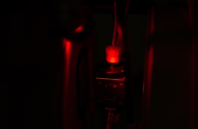Using various spectroscopic methods, researchers at Ruhr-Universität Bochum (RUB) and Philipps-Universität Marburg have gained new insights into how the light-sensitive part of the biomolecule phytochrome changes from a light-adapted to a dark-adapted state. They found that cyanobacterial and plant phytochromes could transduce red and far-red light stimulus into a mechanical output. Their discovery could be put to potential use as an optogenetic tool.
The researchers analyzed a phytochrome molecule from cyanobacteria using a special form of mass spectrometry and electron spin resonance spectrometry. Through the use of these methods, they were able to study the molecule in solution and track its structural changes without having to crystallize it. They observed several characteristic structural changes in the light-sensitive segment of the phytochrome and created a model that showed the light-triggered conversion steps. In addition, the team showed that for different phytochromes, there is a universal mechanism for the transformation from the dark-adapted to the light-adapted state.

 (585) 768-2513
(585) 768-2513

